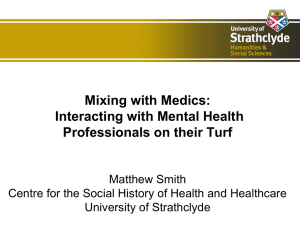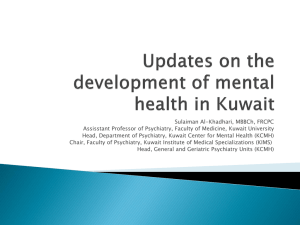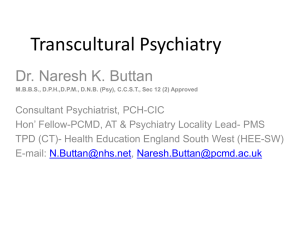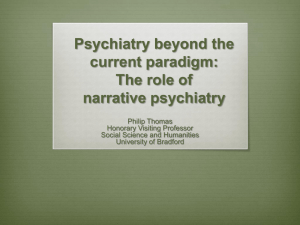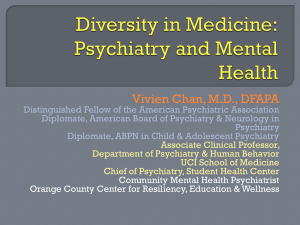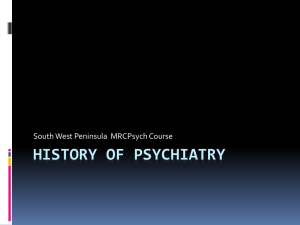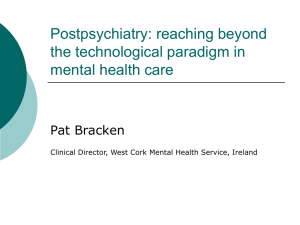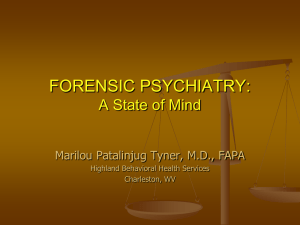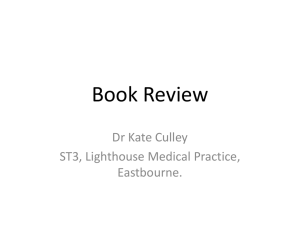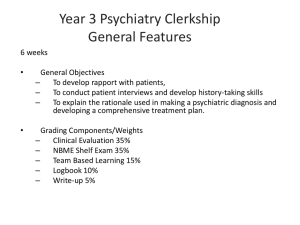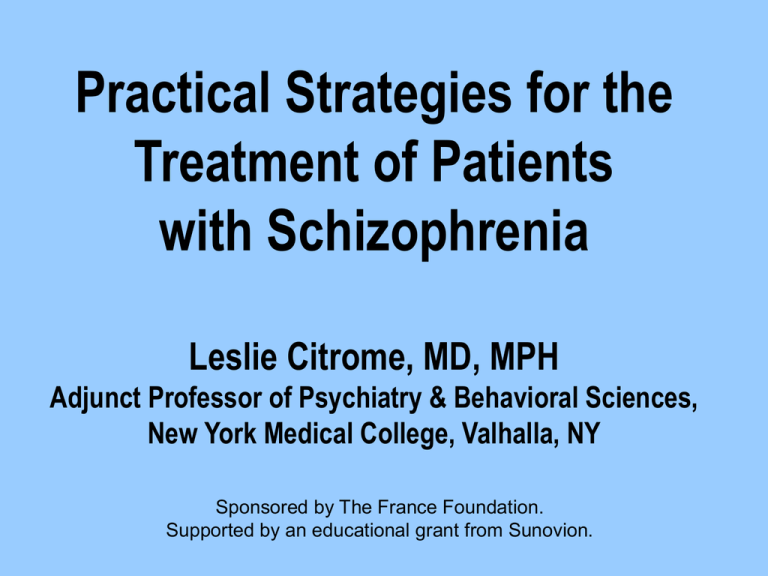
Practical Strategies for the
Treatment of Patients
with Schizophrenia
Leslie Citrome, MD, MPH
Adjunct Professor of Psychiatry & Behavioral Sciences,
New York Medical College, Valhalla, NY
Sponsored by The France Foundation.
Supported by an educational grant from Sunovion.
Faculty Disclosure
It is the policy of The France Foundation to ensure balance,
independence, objectivity, and scientific rigor in all its sponsored
educational activities. All faculty, activity planners, content reviewers,
and staff participating in this activity will disclose to the participants
any significant financial interest or other relationship with
manufacturer(s) of any commercial product(s)/device(s) and/or
provider(s) of commercial services included in this educational activity.
The intent of this disclosure is not to prevent a person with a relevant
financial or other relationship from participating in the activity, but
rather to provide participants with information on which they can base
their own judgments. The France Foundation has identified and
resolved any and all conflicts of interest prior to the release of this
activity.
Disclosure
Leslie Citrome, MD, MPH
Leslie Citrome, is a consultant for, has received honoraria from, or
has conducted clinical research supported by the following:
Abbott, AstraZeneca*, Avanir, Azur, Barr, Bristol-Myers Squibb*, Eli
Lilly*, Forest, GlaxoSmithKline, Janssen*, Jazz, Merck*, Novartis*,
Noven*, Pfizer*, Shire*, Sunovion*, Valeant*, and Vanda.
* Denotes a relationship in effect anytime during the past 12 months
Learning Objectives
• Recognize criteria for remission and recovery in
patients with schizophrenia. Evaluate patients for
the potential to achieve these outcomes and
implement strategies directed towards these goals
• Recognize how clinical practice guidelines relate to
the individualized treatment of patients with
schizophrenia
• Integrate strategies that will help to improve the
effective use of medications by patients with
schizophrenia
Please take pretest now
Schizophrenia – A Set of Symptoms
Positive Symptoms
Suspiciousness/paranoia
Grandiosity/Delusions
Unusual thought content
Negative Symptoms
Blunted affect
Emotional withdrawal
Active social avoidance
Lack of spontaneity
Poor rapport
“Disorganized” Symptoms
Poor attention
Conceptual disorganization
Difficulty in abstract thinking
Disorientation
Clinical and Pathophysiological Course
of Schizophrenia
Lieberman JA, et al. Biol Psychiatry. 2001;50(11):884-897.
What is Response?
•
•
•
•
Speed?
Magnitude?
Proportion responding?
Effect in refractory patients?
Measuring Efficacy - Decrease in PANSS
Lieberman JA, et al. N Engl J Med. 2005;353(12):1209-1223.
Decrease in PANSS Factors
Heresco-Levy U, et al. Biological Psychiatry. 2004;55:165-171.
Arbitrary Categorical Changes in PANSS
Response defined as at
least a 30% decrease from
the baseline PANSS to the
last observation
Daniel DG, et al. Neuropsychopharmacology.1999;20:491-505.
Functionality
Distribution of patients
achieving ≥ 1 change in
Personal and Social
Performance (PSP) Scale
category at end point. Intentto-treat population; PSP
scale scores at end point for
individual patients to show a
clinically relevant change in
personal and social
functioning as represented
by improvement of ≥ 1
category (classified as one
10-point interval);
PSP = Personal and Social
Performance Scale.
Kane J, et al. Schizophr Res. 2007;90:147-161.
What is remission
and recovery in
patients with
schizophrenia?
Response vs Remission
Disease
Response
Remission
Depression
50% ↓ HAM-D
HAM-D ≤ 7
Mania
50% ↓ YMRS
YMRS ≤ 12
Schizophrenia 20-30% ↓ PANSS
?
Andreasen N, et al. Am J Psychiatry. 2005;162:441-449.
Remission Definitions
Andreasen N, et al. Am J Psychiatry. 2005;162:441-449.
Proposed Criteria for Remission
Andreasen N, et al. Am J Psychiatry. 2005;162:441-449.
Recovery
SAMHSA ‘‘Fundamental
Components of Recovery’’
Davidson’s Nine
Common Elements of Recovery
1.
2.
3.
4.
5.
6.
7.
8.
9.
Consumer self-direction
Individualized and person-centered
Redefining self
treatment
Incorporating illness into life as a whole 3. Empowerment
4. A holistic treatment focus
Involvement in meaningful activities
5. A nonlinear perspective of change
Overcoming stigma
6. Treatment focused on strengths instead
of deficits
Assuming control
7. The inclusion of peer support in
Becoming empowered and exercising
treatment
citizenship
8. Respect for consumers and consumer
self-respect
Managing symptoms
9. Consumer acceptance of personal
Finding social support
responsibility
10. Hope in recovery
Renewing hope and commitment
Peebles S, et al. Psych Clin N Am. 2007;30:567-583.
1.
2.
Treatment Effectiveness
Efficacy
Tolerability and
Safety
Does Rx reduce Sx?
Does Rx cause SE?
Treatment
Effectiveness
Combines all measures
Adherence/
Persistence
Will Pt take Rx?
Lehman AF, et al. Am J Psychiatry. 2004;161(2 suppl):1-56.
Swartz MS, et al. Schizophr Bull. 2003;29(1):33-43.
Lieberman JA, et al. N Engl J Med. 2005;353(12):1209-1223.
CATIE Primary Outcome Measure:
All-Cause Treatment Discontinuation
Efficacy
Tolerability
All-Cause
Discontinuation
Clinician Input
Patient Input
Effectiveness
Time to Any-Cause Discontinuation
CATIE Clozapine Pathway Results
McEvoy JP, et al. Am J Psychiatry. 2006;163:600-610.
Effectiveness
Any-Cause Discontinuation: NNT
CATIE Clozapine Pathway
100%
90%
80%
70%
60%
86%
NNT 3
NNT 4
93%
71%
50%
56%
40%
30%
20%
10%
0%
OLZ
RIS
CLO
QUE
McEvoy JP et al. Am J Psychiatry. 2006;163:600-610; Citrome L. Psychiatry MMC. 2007;4(10):23-29;
Citrome L and Stroup TS. Int J Clin Pract.2006;60:933-940.
What else do I need
to know about
recovery?
Hierarchies of Outcome: Recovery is at Top
Recovery
Remission
Stabilization
Criteria for Recovery?
•
•
•
•
•
Symptom remission
Vocational functioning
Independent living
Peer relationships
Duration ≥ 2 years
Is recovery best viewed as an outcome or a process?
Liberman P, et al. Int Rev Psychiatry. 2002;14:256-272.
Liberman P, Kopelowicz. Psychiatr Serv. 2005;56:735-742.
Recovery – A Matter of Perspective
• Recovery from Illness
– Cure of illness, absence of illness
versus
• Recovery in Illness: being in recovery
– Process of managing illness more effectively
– Having a meaningful life in the community
– Moving ahead with one’s life despite illness
Davidson L, et al. Schizophr Bull. 2008;34:5-8.
Process of Recovery
The Person
Play
The Illness
The Person
The Person
Work
Family
The
Illness
Friends
The
Illness
Factors Associated with the Potential for Positive
Clinical and Functional Outcomes
Short duration of untreated psychosis
Good early response to antipsychotic treatment
Collaborative therapeutic alliance
Supportive family/caregivers
Access to comprehensive, coordinated, and
continuous treatment
• Opportunities to engage in functional activities
and receive specialized interventions
• Absence of substance abuse
•
•
•
•
•
What about
cognition in
patients with
schizophrenia?
Cognitive Deficits Are the Bridge Between Brain
Functioning and Functional Impairments
in Day-to-Day Life
• Cognitive deficits are a frequent and robust
feature of the illness
• Cognitive deficits are present at illness onset
and persist throughout the illness
• Cognitive deficits directly contribute to poor
functional outcome in schizophrenia
Normative Data Compared to a Schizophrenia
Sample on the RBANS Neuropsychological Test
Schizophrenia (n = 575)
Normal
controls (n
= 540)
from
standardization
sample
35
% of Cases
30
25.0%
25
22.8%
25.0%
22.6%
20.6%
20
16.5%
16.0%
16.0%
15
10
7.2%
7.9%
7.0%
7.0%
0.4%
5
1.6%
0%
0
< 50-50
0.4%
2.2%
51-60
61-70
0.4%
0%
71-80
81-90
91-100 101-110
111-120 121-130
Total Scale Score
RBANS: Repeatable Battery for Assessment of Neuropsychological Status
Wilk CM, et al. Schizophr Res. 2004;70(2-3):175-186.
0%
1.6%
0%
131-140 140+
Components of Psychosocial Rehabilitation
Neurocognition
• Attention
• Processing
• Memory
• Reasoning
• Verbal learning
• Visual learning
Social Cognition
• Emotion
processing
• Social perception
• Attributional bias
• Theory of mind
Kurzban S, et al. Curr Psychiatry Rep. 2010;12:345-355.
Motivational
Aspects
• External
• Intrinsic
Outcomes
• Functional
• Subjective
Cognitive Remediation
• Behavioral treatments that specifically target:
–
–
–
–
Memory
Attention
Executive functioning
Reasoning
• Restorative cognitive techniques – drill and practice
– Paper & pencil tasks
– Computerized training software
COGPACK, Posit Science Brain Fitness, etc.
– Individual
– Groups
– Compensatory cognitive training – promote adaptive behavior
• Enhance daily functioning
– School, work, social interactions, independent living
• Enhance skills pertinent to recovery goals
Medalia A, Choi J. Neuropsychol Rev. 2009;19:353-364.
Work and Schizophrenia
~20% employed
80% Unemployed
Barriers
•
•
•
•
•
•
55–70% identify employment as a goal
Cognitive impairments
Psychiatric symptoms
Episodes of illness
Stigma from employers
Internalized stigma/low self-confidence
Fear of losing disability benefits
McGurk S, et al. Schizophr Bull. 2009;35:319-335.
Kurzban S, et al. Curr Psychiatry Rep. 2010;12:345-355.
Vocational Rehabilitation
• Skills training
• Sheltered workshops
• Transitional employment
• Supported employment
Vocational rehabilitation + cognitive remediation → best
results
Employment =
• Increased self esteem
• Reduction in symptoms and hospitalizations
• Enhanced social functioning
• Improvement in overall quality of life
McGurk S, et al. Schizophr Bull. 2009;35:319-335.
Kurzban S, et al. Curr Psychiatry Rep. 2010;12:345-355.
Supported Employment
Basic Principles
1. Zero exclusion; eligibility based on consumer choice
2. Focus on competitive jobs in integrated community
settings
3. Rapid job search
4. Respect for consumers’ preferences in terms of the
nature of the job and types of support services
5. Ongoing job support
6. Close integration with a psychosocial rehabilitation
team approach
7. Benefits counseling (disability benefits, social security,
medical insurance)
McGurk S, et al. Schizophr Bull. 2009;35:319-335.
Optimizing Employment Outcomes
Vocational Rehabilitation (VR) + Cognitive Remediation (CR)
45
*
40
30
3000
2500
**
Wages Earned
Weeks Worked
35
VR
VR + CR
2000
25
1500
20
15
*
1000
10
500
5
0
Competitive Hospital-based
Community
Internship
Work
Total
0 Competitive Hospital-based
Community
Internship
Work
Total
* P < 0.05; ** P < 0.01
VR + CR: Greater improvements in verbal learning, memory, executive functioning vs VR only
McGurk S, et al. Schizophr Bull. 2009;35:319-335.
Cognitive remediation with COGPACK training software
What can
guidelines tell us?
Management of Schizophrenia
Patient-focused therapeutic alliance
Individualized approach
Reduce or eliminate symptoms
Optimize quality of life
Assist patients in attaining personal life goals (work,
housing, relationships)
• Guidelines and algorithms provide a framework for
decision making
•
•
•
•
•
Guideline/Algorithm Recommendations
APA
TMAP
PORT
2004
2006
2009
SGA
SGA
SGA, FGA
SGA, FGA, C
SGA, FGA
SGA, FGA
C
C
C
(C+)
C+
–
Fifth choice
–
A,T
–
Combinations
–
CF
–
First episode
Second choice
Third choice
Fourth choice
FGA: first-generation antipsychotic
SGA: second-generation (atypical) antipsychotic
C: Clozapine
C+: Clozapine augmentation
CF: Clozapine failure
Practice Guideline for the Treatment of Patients with Schizophrenia. 2nd Edition. APA. 2004.
Moore T, et al. J Clin Psychiatry. 2007;68:1751-1762.
Kreyenbuhl J, et al. Schizophr Bull. 2010;36:94-103.
PORT Psychosocial Treatment
Patient Outcomes Research Team
Recommendations for:
• Assertive community treatment
• Supported employment
•
•
•
•
Skills training
Cognitive behavioral therapy
Token economy interventions
Family-based services
• Interventions for alcohol and substance abuse
disorders
• Interventions for weight management
Dixon L, et al. Schizophr Bull. 2010;36:48-70.
What is it that we
actually do?
Survey of APA Practice Research Network:
Schizophrenia Treatments
100
Percent Receiving
Recommended Treatment
90
80
70
60
50
40
30
20
10
0
Use of
Dose in Range
Antipsychotic
West J, et al. Psych Services. 2005;56:283-291.
Illness
education
Vocational
Rehabilitation
Substance
Abuse
Treatment
Any
Psychosocial
Treatment
Real-World Antipsychotic
Treatment Practices
• Second-generation antipsychotics are used in over 70% of
individuals with schizophrenia (use may be higher in first-episode
patients)
• Rate of clozapine use is much lower than the incidence of
treatment-resistant schizophrenia
• Antipsychotic polypharmacy
– ~10 to 30% of individuals with schizophrenia
– FGA + SGA most common combinations
• Use of adjunctive medications
– Baseline data from CATIE
Antidepressants (38%), anxiolytics (22%), sedative hypnotics (19%), lithium
(4%), other mood stabilizers (15%)
• Dosage of antipsychotic medications within therapeutic range 64
to 83% of the time during inpatient treatment
Moore T, et al. Psychiatr Clin N Am. 2007;30:401-416.
What do we know
about efficacy and
tolerability of
antipsychotic
medication?
Meta-Analyses Demonstrate the Heterogeneity for
Antipsychotic Response
“All antipsychotics are equal, but some are more equal than others”
- Volavka J, Citrome L. J Clin Psychiatry. 2009;70:429-430.
SGA versus FGA
Amisulpride Aripiprazole Clozapine Olanzapine Quetiapine Risperidone Sertindole Ziprasidone Zotepine
Leucht S, et al. Lancet. 2009;373(9657):31-41.
Meta-Analyses Demonstrate the Heterogeneity for
Antipsychotic Response
“All antipsychotics are equal, but some are more equal than others”
- Volavka J, Citrome L. J Clin Psychiatry. 2009;70:429-430.
SGA versus
SGA
Advantages for:
Clozapine
Olanzapine
Risperidone
Leucht S, et al. Am J Psychiatry. 2008;166(2):152-163.
Antipsychotics – Heterogeneity for Tolerability
EPS, Prolactin, Weight, Glucose/Lipids, Sedation, Hypotension
Volavka J, Citrome L. Expert Opin Pharmacother. 2009;10(12):1917-1928.
CATIE – Reasons for Discontinuation
80%
70%
74%
N=1432
60%
50%
WEIGHT GAIN - METABOLIC EFFECTS
40%
4.0%
4.0%
1.8%
4.9%
30%
20%
24%
10%
OTHER
EXTRAPYRAMIDAL EFFECTS
SEDATION
30%
6%
15%
0%
ALL CAUSE
LACK OF
EFFICACY
INTOLERABILITY
Lieberman JA, et al. N Engl J Med. 2005;353(12):1209-1223.
PATIENT
DECISION
OTHER REASONS
How do we manage
this heterogeneity?
We Can Use Evidence-Based Medicine
Clinical
Judgment
EBM
Relevant
Scientific
Evidence
Patients’
Values and
Preferences
Sackett DL, et al. BMJ. 1996;312(7023):71-72.
Citrome L, Ketter TA. Int J Clin Pract. 2009;63(3):353-359.
What Is Treatment Effectiveness?
Efficacy
Tolerability
and Safety
Does Rx reduce
Sx?
Does Rx cause
SE?
Treatment
Effectiveness
Combines all measures
Adherence/
Persistence
Will Pt take Rx?
Lehman AF, et al. Am J Psychiatry. 2004;161(2 suppl):1-56.
Swartz MS, et al. Schizophr Bull. 2003;29(1):33-43.
Lieberman JA, et al. N Engl J Med. 2005;353(12):1209-1223.
Effective Use of Medication
• Medication is a tool that a person with schizophrenia can use to
take greater control over his or her life
• The goal should be to maximize the effectiveness of medication
to help the person live the kind of life that he or she wants to
live
• The medicine has work well enough, be
tolerated well enough, and the patient has to
take it
Medication Nonadherence
• Prevalence ~30 to 50% (and higher); rates vary
depending on clinical setting, definitions, study
duration, study population
• Relatively short gaps in medication coverage can
increase the risk of relapse
• Nonadherence is associated with poor outcomes
– Relapse
– Hospitalization
– Suicide attempts
Lacro J, et al. J Clin Psychiatry. 2002;63:892-909.
Novick D, et al. Psychiatry Res. 2010;176:109-113.
Masand P, et al. Prim Care Companion J Clin Psychiatry. 2009;11:147-154.
How can we manage non-adherence?
Step 1:
Admit the possibility of partial or
nonadherence
We Overestimate Adherence
– Nonadherence viewed as failure → consistent bias
to overestimate adherence/underestimate
nonadherence
– We assume lack of adequate response as
“treatment-resistance” and lack of efficacy for the
antipsychotic for that patient
This is a possible explanation for high dosing of antipsychotics,
polypharmacy with other antipsychotics and combination
treatment with anticonvulsants
– This is a no-win cycle: adherence is even more of a
challenge with complex regimens
Velligan DI, et al. Psychiatr Serv. 2007;58(9):1187-1192.
Step 2:
Identify the specific barriers to
adherence present for your patient
Risk Factors for Nonadherence
Patient-related1
• Poor insight
• Negative attitude
toward medication
• Prior nonadherence
• Substance abuse
• Cognitive impairment
Treatment-related1
• Side effects
• Lack of efficacy/
continued symptoms
Environment/Relationship-related1
• Lack of family/social support
• Problems with therapeutic alliance
• Practical problems
(financial, transportation, etc)
Societal-related2
• Stigma attached to illness
• Stigma caused by medication
side effects
1. Velligan DI, et al. J Clin Psychiatry. 2009;70(suppl 4):1-46.
2. Lee S, et al. Soc Sci Med. 2006;62(7):1685-1696.
Risk Factors for Nonadherence
Patient-related1
• Poor insight
• Negative attitude
toward medication
• Prior nonadherence
• Substance abuse
• Cognitive impairment
Treatment-related1
• Side effects
• Lack of efficacy/
continued symptoms
Environment/Relationship-related1
• Lack of family/social support
• Problems with therapeutic alliance
• Practical problems
(financial, transportation, etc)
Societal-related2
• Stigma attached to illness
• Stigma caused by medication
side effects
1. Velligan DI, et al. J Clin Psychiatry. 2009;70(suppl 4):1-46.
2. Lee S, et al. Soc Sci Med. 2006;62(7):1685-1696.
Barriers to Therapeutic Alliance
in Schizophrenia
● Patient barriers1
– Communication difficulties
– Difficulty forming an alliance because of negative symptoms
– Difficulty learning from experience because of cognitive
symptoms
– Rejection of diagnosis due to stigma
● Clinician barriers2
– Underestimating importance of relationship
– Hopelessness conveyed to patient
– Lack of interest in life goals and other issues important to patient
1. Velligan DI, et al. J Clin Psychiatry. 2009;70(suppl 4):1-46.
2. Pitschel-Walz, G, et al. J Clin Psychiatry. 2006;67(3):443-452.
Adherence After 6 Months, %
Relationship Between Early Alliance
and Later Medication Adherence:
The Boston Collaborative Study
aP
80
74
60
40
26a
28a
20
0
Good
Fair
Alliance at 6 Months
< 0.001
Frank AF, Gunderson JG. Arch Gen Psychiatry. 1990;47:228-235.
Poor
Assessing Medication Adherence:
Interview Style
Ask for the patient’s view about medications1,2
Obtain sufficient information before responding3
Do not jump to conclusions; take comments at face value3
Explain that you want to hear what the patient really thinks, not
what he/she thinks you want to hear1-3
● If you want to respond, do not try to do too much and make
sure you do not go beyond what the patient can accept for now
● As much as you can, try to keep the discussion about
medication adherence positive—even enjoyable1
● Above all, try to maintain and even strengthen the alliance,
even if there is disagreement about the need for medication1
●
●
●
●
1. Weiden, PJ. J Psychiatr Prac. 2002;8(6):386-392.
2. McCabe R, et al. BMJ. 2002;325(7373):1148-1151.
3. Weiden PJ. J Clin Psychiatry. 2007;68(suppl 14):14-19.
Assessing Medication Adherence:
Interview Style
“Have you been taking your medications?” or “You have been
taking your medicines, right?”
“Everyone misses doses of their medicines. Can you give me
some idea of how many doses do you usually miss in any
given week? I just need a ball-park figure, you don’t have to be
exact.”
This is followed by, “What doses do you miss the most –
morning? evening? with meals? in between meals? This way
we can figure out the best time of day to use these medications
so we can minimize the number of times you may miss them.”
Risk Factors for Nonadherence
Patient-related1
• Poor insight
• Negative attitude
toward medication
• Prior nonadherence
• Substance abuse
• Cognitive impairment
Treatment-related1
• Side effects
• Lack of efficacy/
continued symptoms
Environment/Relationship-related1
• Lack of family/social support
• Problems with therapeutic alliance
• Practical problems
(financial, transportation, etc)
Societal-related2
• Stigma attached to illness
• Stigma caused by medication
side effects
1. Velligan DI, et al. J Clin Psychiatry. 2009;70(suppl 4):1-46.
2. Lee S, et al. Soc Sci Med. 2006;62(7):1685-1696.
Medication-related Side Effects
and Nonadherence
● Potential drivers
– Level of distress rather than severity
– Attribution to the medication
– Vary from patient to patient
● Most commonly associated with nonadherence
–
–
–
–
–
–
Weight gain
Sedation
Akathisia
Sexual dysfunction
Parkinsonian symptoms
Cognitive problems
Velligan DI, et al. J Clin Psychiatry. 2009;70(suppl 4):1-46.
Reverberations From Side Effects
How Patient and Clinician Responses May Differ
Side effect
appears
Subjective
Distress
Adherence
Impact
Objective
Severity
Safety and Risk
Weiden PJ, Buckley PF. J Clin Psychiatry. 2007;68(suppl 6):14-23.
Considering Side Effect Profile
When Choosing Treatment
Important because side effects may1:
– Contribute to treatment nonadherence
– Limit return to maximal levels of social functioning
– Potentially contribute to long-term morbidity
Atypical antipsychotics are better tolerated than typical
antipsychotics (mainly due to decreased EPS)2
Differences in drug-specific adverse effect profiles,
including metabolic effects, may impact treatment
adherence and long-term outcomes1,2
1. Velligan DI, et al. J Clin Psychiatry. 2009;70(suppl 4):1-46.
2. Tandon R. Psychiatr Q. 2002;73(4):297-311.
Risk Factors for Nonadherence
Patient-related1
• Poor insight
• Negative attitude
toward medication
• Prior nonadherence
• Substance abuse
• Cognitive impairment
Treatment-related1
• Side effects
• Lack of efficacy/
continued symptoms
Environment/Relationship-related1
• Lack of family/social support
• Problems with therapeutic alliance
• Practical problems
(financial, transportation, etc)
Societal-related2
• Stigma attached to illness
• Stigma caused by medication
side effects
1. Velligan DI, et al. J Clin Psychiatry. 2009;70(suppl 4):1-46.
2. Lee S, et al. Soc Sci Med. 2006;62(7):1685-1696.
What Type of Intervention
Is Appropriate?
● If the adherence problem is that the patient WILL NOT,
focus intervention on strengthening perceived benefits of
medication and minimizing perceived costs
● If the adherence problem is that the patient CANNOT, then
address barriers to adherence
– Pill boxes in obvious locations
– Self-monitoring tools
– Establishment of routines
– Consider long-acting injectable antipsychotic
Weiden P. J Clin Psychiatry. 2007;68(suppl 14):14-19.
Risk Factors for Nonadherence
Patient-related1
• Poor insight
• Negative attitude
toward medication
• Prior nonadherence
• Substance abuse
• Cognitive impairment
Treatment-related1
• Side effects
• Lack of efficacy/
continued symptoms
Environment/Relationship-related1
• Lack of family/social support
• Problems with therapeutic alliance
• Practical problems
(financial, transportation, etc)
Societal-related2
• Stigma attached to illness
• Stigma caused by medication
side effects
1. Velligan DI, et al. J Clin Psychiatry. 2009;70(suppl 4):1-46.
2. Lee S, et al. Soc Sci Med. 2006;62(7):1685-1696.
Step 3:
Monitoring adherence
Monitoring Medication Adherence
● There are no entirely satisfactory methods, but can
count pills and measure plasma levels
● Ask if the patient is taking his/her medications
● Ask, are the medications doing any good?
– Any perceived benefit (eg, sleeping better) is a
treasure
– If none, be worried
● Ask, are the medications doing any harm?
– Ask about being sleepy, slowed down, dulled
– Ask about weight changes
– Ask about constipation
– Ask about sex
Velligan DI, et al. J Clin Psychiatry. 2009;70(suppl 4):1-46.
Step 4:
Consider a depot antipsychotic
Considering Efficacy
When Choosing Treatment
Someone who isn’t responding adequately to an oral
medication is unlikely to then respond to its depot
formulation
Unless they were a non-responder because of nonadherence
There is heterogeneity in efficacy outcomes among the
different antipsychotics, and this heterogeneity is observed
among groups in clinical trials and in individual patients
Potential Advantages of Long-acting
Injectable Antipsychotics
Reduces dosage deviations1
Eliminates guessing about adherence status2,3
Shows start date of nonadherence2,3
Helps disentangle reasons for poor response to medication3
Eliminates need for the patient to remember to take a pill daily1
Enables prescribers to avoid first-pass metabolism, therefore a
better relationship between dose and blood level exists1
Results in predictable and stable plasma levels1
Eliminates abrupt loss of efficacy if dose missed1,3
Many patients prefer them, especially if already receiving them4
1.
2.
3.
4.
McEvoy JP. J Clin Psychiatry. 2006;67(suppl 5):15-18.
Olfson M, et al. Schizophr Bull. 2007;33(6):1379-1387.
Kane JM, et al. J Clin Psychiatry. 2003;64(suppl 12):5-19.
Patel MX, et al. J Psychiatr Ment Health Nurs. 2005;12(2):237-244.
Potential Obstacles to Long-acting
Injectable Antipsychotics
Lack of infrastructure in outpatient settings
Need to refrigerate, store, reconstitute, etc.
Overburdened public agencies
Frequency of injections and consequent inconvenience
for staff and patients
Need to take concomitant medications orally
Anti-shot sentiment
McEvoy JP. J Clin Psychiatry. 2006;67(suppl 5):15-18.
Kane JM, et al. J Clin Psychiatry. 2003;64(suppl 12):5-19.
Determinants of Depot Use
Citrome L, et al. Psychopharmacol Bull. 1996;32(3):321-326.
Depot Antipsychotics Reduce Relapse
in Long-term Studies
Study
Treatment
n/N
Control
n/N
Relative Risk
(95% CI Random)
Relative Risk
(95% CI Random)
Barnes 1983
Falloon 1978
Hogarty 1979
Quitkin 1978
Rifkin 1977
Crawford 1974
DelGuidice 1975
Schooler 1973
3/19
8/20
22/55
5/29
1/19
2/14
21/27
26/107
3/17
5/24
32/50
4/27
4/24
6/15
59/61
35/107
0.89 (0.21, 3.85)
1.92 (0.74, 4.95)
0.62 (0.43, 0.92)
1.16 (0.35, 3.89)
0.63 (0.06, 6.45)
0.36 (0.09, 1.48)
0.80 (0.65, 0.99)
0.74 (0.48, 1.14)
Total (95% CI)
88/290
146/325
0.78 (0.66, 0.91)
Overall effect z = 3.06; P = 0.002
.1 .2
Favors Treatment
1
5
10
Favors Control
Mentschel C, et al. Presented at: The International Congress on Schizophrenia Research
(ICOSR) 2003; March 29-April 2; Colorado Springs, Colorado.
Relapse-free Survival Rates With
Oral and Depot Fluphenazine
Proportion Surviving
10
9
8
7
6
5
4
3
2
1
0
Fluphenazine decanoate (n = 55)
Oral fluphenazine (n = 50)
0
3
6
9
12
15
Months in Community
Hogarty GE, et al. Arch Gen Psychiatry. 1979;36(12):1283-1294.
18
21
24
Adherence Summary
Strategies to improve adherence include
– Admitting that partial or nonadherence is a possibility
– Identifying risk factors specific to the individual
– Addressing barriers to therapeutic alliance
– Tailoring interventions to adherence attitudes and
behavior
Pharmacologic strategies to improve adherence include
– Considering patient history, efficacy, and side effect
profile when choosing treatment
– Considering utilizing long-acting injectable
antipsychotics, if available, in patients with recurring
relapses related to nonadherence
Summary
• Response, remission and recovery are necessary goals of
treatment, but each can be interpreted differently by
clinicians, patients, and their families
• Clinical practice guidelines can provide advice regarding a
comprehensive approach, unfortunately not often done
• Treatment effectiveness is dependent on a medication being
efficacious enough, tolerable enough, and the patient has to
take it
• Adherence can be the ultimate confounder regarding
effectiveness
Please take posttest now and complete the
attestation/evaluation form
Questions?
nntman@gmail.com

